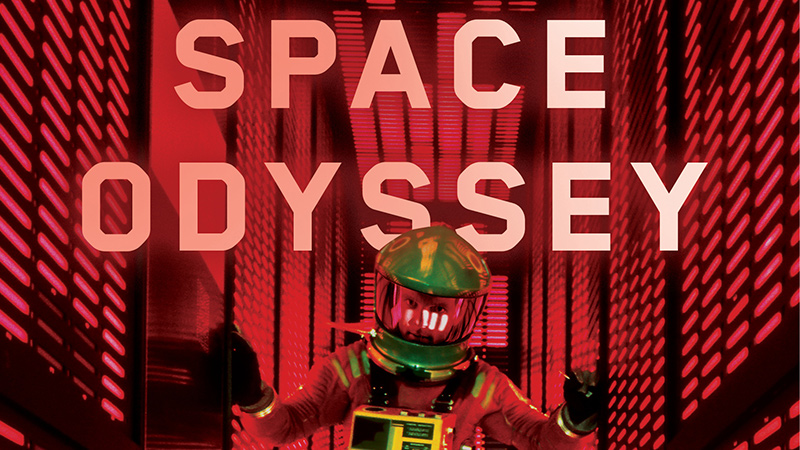Stay Up to Date
Submit your email address to receive the latest industry and Aerospace America news.
Michael Benson chronicles the making of the Oscar-winning film 50 years later
Nations around the world are planning missions to the moon; businesses are meeting to discuss mining of deep space resources; and artificial intelligence is becoming a part of daily life. The Oscar-winning movie “2001: A Space Odyssey” is among the works of science fiction that inspired the age of space exploration that we live in today, and its filmmakers did so by brainstorming with space and technology visionaries before Apollo 11 had even landed the first humans on the moon.
Michael Benson, a filmmaker and author of several books about space, exhaustively researched the making of the 1968 cult classic for his new book “Space Odyssey: Stanley Kubrick, Arthur C. Clarke, and the Making of a Masterpiece.” The book is due out in the U.S. and Canada in April to commemorate the film’s 50th anniversary.
Benson richly describes how filmmaker Stanley Kubrick and novelist Arthur C. Clarke met in 1964 to co-write a movie about concepts including extraterrestrials, human exploration and the power of technology to both create and destroy.
Benson outlines the film’s origin by drawing on candid photos from the film set, interviews with friends and colleagues of the late Kubrick and Clarke, including Kubrick’s widow, and the men’s personal journals. This saga also features encounters they had with icons including astrophysicist Carl Sagan and beat poet Allen Ginsberg, and other details that immerse readers in the zeitgeist of 1960s London and New York City.
The movie envisioned people from all nations living on the moon and space stations, albeit with Russians and Americans researching separately. Cold War rivalry between Russia and the U.S. was at its peak when the film debuted in 1968, and Kubrick was fresh off the success of his Oscar-nominated “Dr. Strangelove” about nuclear war. Americans in the film lead the fateful mission to Jupiter where the crew of the Discovery was sent to search for alien life with the spaceship’s HAL-9000, an artificial intelligence character now synonymous with visions of a machine uprising.
Cinephiles will love details about the auteurs and stories of actors on the set, but these can sometimes overshadow examples in the 444-page book of the film’s space futurism that inspired science fiction filmmakers including George Lucas and Stephen Spielberg.
Benson recounts how the smallest details in the film’s sets, costumes and backstory were all made by Clarke and Kubrick with an eye for capturing how humanity’s journey into space would shape society. The production team of “2001” included German-born designer Harry Lange, who had previously worked at NASA as the head of its “future projects” section, and Frederick Ordway, NASA’s former chief of space information systems, who had helped develop the Saturn 5 rocket. Bell Labs, IBM and Hewlett Packard were among the tech firms that advised the filmmakers.
The sentient supercomputer HAL-9000 was created with expertise from cryptologist I.J. Good and cognitive scientist Marvin Minsky.
Kubrick created the illusion of microgravity with tricks including foreground sets locked to a camera that rotated as the backgrounds remained stationary, giving the illusion of a corridor spinning in space. To add context for Kubrick’s ingenuity to simulate space travel, Benson’s book has received advance praise from Hollywood veterans, including Tom Hanks, who performed scenes in microgravity during “Apollo 13” by filming on NASA’s KC-135 plane.
Benson’s book made me realize that in the decades after the debut of “2001,” life is not imitating art but it’s not far off. Airliners are not ferrying people to a Hilton hotel on a space station that spins to maintain gravity but rocket company Blue Origin’s Jeff Bezos has spoken about space tourism as a potential business model. There is no moon base, but efforts to send humans back to the moon are more international than Kubrick and Clarke dreamed of during the Cold War. Russia and the U.S. are collaborating on a Lunar Orbital Platform-Gateway space station for an orbit between Earth and the moon. The European Space Agency is also gathering international commitments to partner on a Moon Village, which is intended to be a research station on the lunar surface open to all nations.
NASA is also designing the Europa Clipper probe to orbit Jupiter and search for extraterrestrial life on the icy moon of Europa. The probe probably won’t find a giant black monolith left by aliens or rebel against NASA like HAL-9000, but the mission will take humans on the next step of our space odyssey.
SPACE ODYSSEY: STANLEY KUBRICK, ARTHUR C. CLARKE, AND THE MAKING OF A MASTERPIECE
By Michael Benson, Simon & Schuster, $30 hardcover
About Tom Risen
As our staff reporter from 2017-2018, Tom covered breaking news and wrote features. He has reported for U.S. News & World Report, Slate and Atlantic Media.
Related Posts
Stay Up to Date
Submit your email address to receive the latest industry and Aerospace America news.




